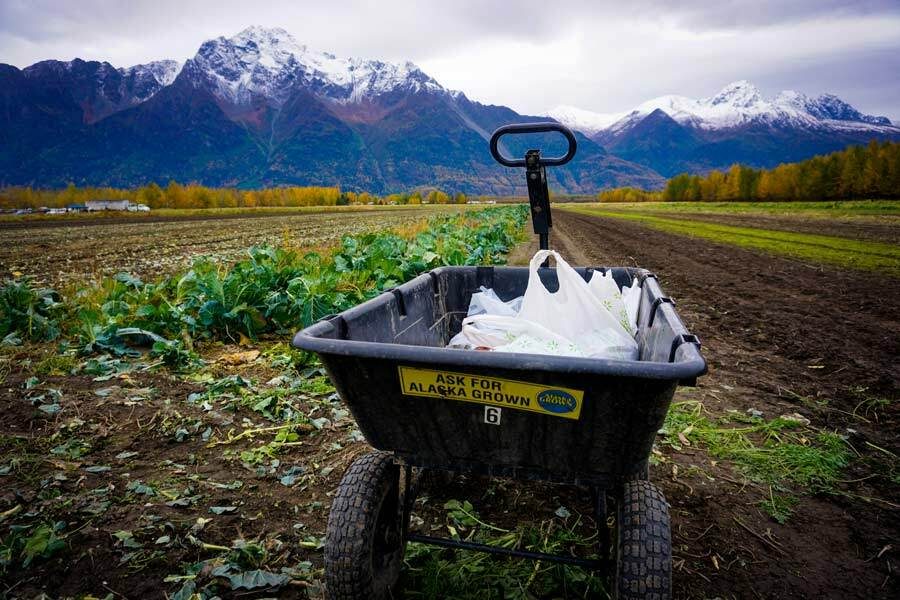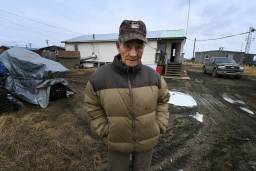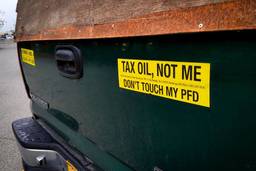Climate Change Is Fueling a Farming Boom in Alaska
It’s becoming easier for the northern state to grow its own food—and more necessary.
Yereth Rosen

ANCHORAGE, ALASKA — Snow is on the mountains. There’s a nip in the October air. Patches of dirt are freezing. But reminders of the past summer’s heat are poking out of the ground at the tiny Grow North Farm.
The dried stalks are leftovers of what might seem an unlikely Alaska crop: dodo plants, a member of the amaranth family, which produces leafy, collard-like greens and grains in sub-Saharan Africa and South America.
These plants were cultivated by a Congolese family that, after three years in Anchorage, wanted to bring a taste of home. The crop was wildly successful during Anchorage’s sweltering summer, during which temperatures hit 90 degrees for the first time on record, says Nick Bachman of Anchorage Community Land Trust, the nonprofit that operates Grow North Farm.
“What we found with the dodo was: Just add water,” Bachman says.
This 28,000-square-foot urban farm is surrounded by a gas station, a strip mall, a middle school and rows of apartments. It was carved from a lot that once held an RV park, a remediation and construction project that took years. The farm, with more than 20 independent growers operating plots, opened this spring.
It is not the only new farm in Alaska.
From 2012 to 2017, the number of farms increased by 30% while total U.S. farms dropped by more than 3%, according to data from the U.S. Department of Agriculture’s 2017 Census of Agriculture. Alaska’s growth is largely in small farms of 1 to 9 acres — up 73% those same years. The value of farm goods sold directly to consumers doubled from $2.2 million to $4.4 million in that time — still less than almost any other state, but growing fast.
Like much of the country, Alaska is gripped by a local-food movement with a range of benefits, including economic opportunities for immigrants and newly settled refugees. Many of the new arrivals were smallscale farmers in their home countries, Bachman says.
But there is a special force behind Alaska’s farming boomlet: climate change.
Alaska is warming twice as fast as the global rate, and changes in the state are accelerating. Of Alaska’s 10 warmest years since the late 1800s, eight have occurred since 2000, according to the International Arctic Research Center (IARC) at the University of Alaska Fairbanks. That doesn’t include 2019, which has smashed heat records.
As Alaska warms, its growing season has lengthened — in Fairbanks, for example, by 45% since 1900, according to a 2009 study — enabling the cultivation of new crops such as corn, cherries and dodo.
Climate change also makes Alaskan farming more urgent.
In May, the Anchorage city government adopted a climate action plan warning that extreme weather events will delay food imports, on which Alaskans have near-total reliance. The plan encourages urban farming and gardening.
Local farming also reduces carbon footprints. Almost all of the small-scale farmers who use the Grow North site, Bachman says, walk there or use public transit. After harvest, farmers sell from the open-air sales stand at the entrance — no fossil-fuel vehicles required.
The farming trend extends to rural Alaska, where there is a higher Native Alaskan population and traditional wild foods are becoming more difficult to obtain. The overheated waters of western Alaska caused mass die-offs of salmon this year, for example, and thinning ice on the rivers and seas makes hunting far more treacherous. Though agriculture is not generally part of indigenous tradition, farms and gardens are now helping fill the gaps.
Farming does have some Alaska-specific challenges. Ashley Taborsky, of the blog Alaska Urban Hippie, has converted her south Anchorage yard to a miniature farm with fencing to moose-proof her young apple and cherry trees. So far, unlike some Alaskan farmers, she has not had bears successfully raid her chicken coop.
There are also advantages.
Alaska, for now, lacks many of the pests that plague southern farms. Relatively cool temperatures and extended summer daylight stimulate sugar production in root vegetables (Alaska carrots are famous for their sweetness) and, sometimes, immense proportions: a giant cabbage weigh — off is a revered ritual at the Alaska State Fair in the Matanuska Valley town of Palmer, with a world-record 138.25-pound specimen winning in 2012.
Matanuska became Alaska’s farming heartland in the 1930s, thanks to a New Deal program that lured Midwestern farmers north. But the 1970s oil boom, combined with the rise of agribusiness in the lower 48, put the farming sector in a slump. Alaskan farmers struggled to compete with imported, massproduced foods and struggled to resist the temptation to cash in, selling off farmland to accommodate the oil-fueled population influx.
Today, Alaska’s oil production is about a quarter of its 1980s peak.
“If oil is declining, then what’s next?” Bachman says. “I think there is a unique opportunity to allow local foods … to become a larger wedge of the economy.”
Bob Shumaker, owner of Black Bear Farms in Palmer and a former president of the Alaska Farmers Union, hopes agriculture expands with a revived northward migration of farmers.
“Everybody down south who’s too hot — move to Alaska,” he says. “It’s great.”








